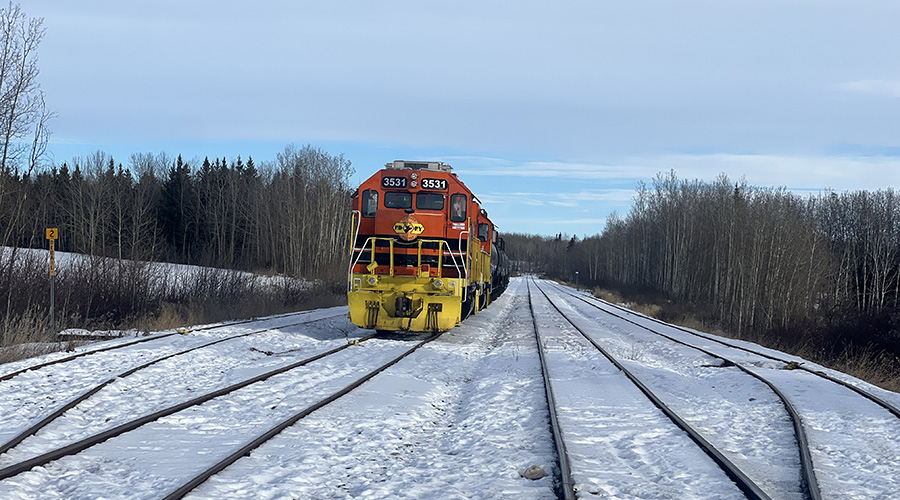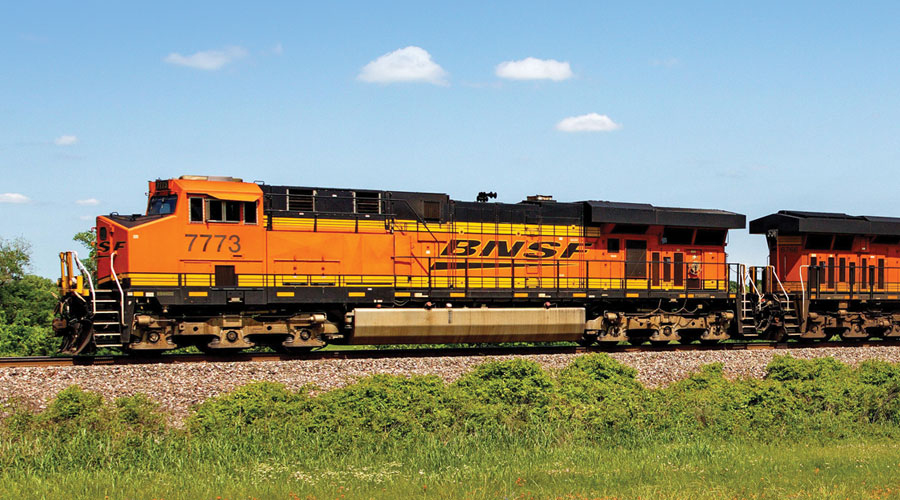Stay updated on news, articles and information for the rail industry
July 2023
Rail News: BNSF Railway
Intermodal in play: BNSF commits more capital, capacity to its most lucrative business group
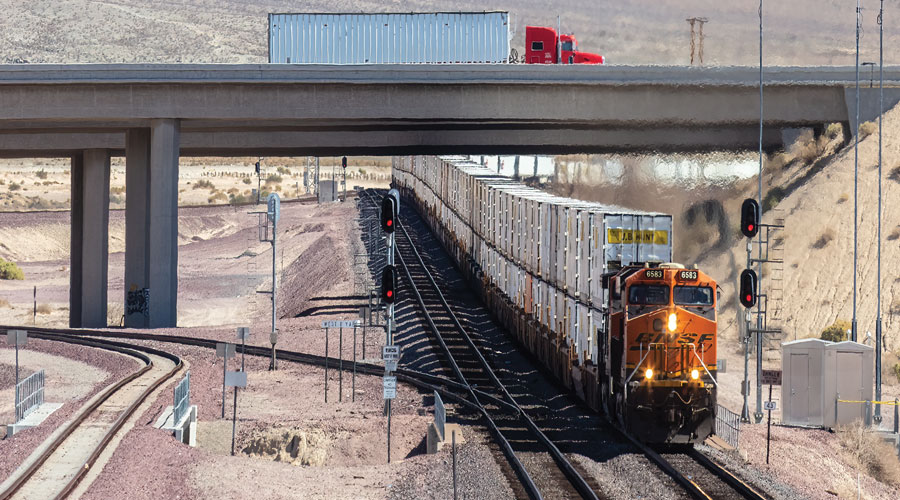
By Jeff Stagl, Managing Editor
BNSF Railway Co. divides its business into three main groups: agricultural products, consumer products and industrial products. But one of them clearly is the rainmaker.
The consumer products group — or intermodal franchise — generates more than one-third of annual revenue and about half of annual volume. In first-quarter 2023, the group accounted for $1.9 billion of $5.7 billion in total revenue and 1 million-plus of 2.1 million units in total volume.
BNSF handles about 1 million more intermodal loads annually than its closest competitors. And although the North American intermodal market remains soft since swollen retail inventories still are being worked off, consumer spending is erratic and supply chains until recently were disrupted at U.S. West Coast ports due to a longshoremen labor action, the Class I’s potential to build consumer products business remains high, BNSF leaders believe.
“Intermodal is our largest segment with the most growth potential,” said BNSF President and CEO Katie Farmer in an email.
But to realize that potential, the Class I needs to execute a few critical maneuvers. For one, enough resources — such as equipment and manpower — need to be put in place to support additional business opportunities.
To that end, BNSF is trying to ensure it’s well staffed. The Class I hired 3,000 new employees last year — about half for train and engine-service positions — and expects to hire another 3,000 this year. Equipment-wise, the railroad recently created a stand-ready fleet of 100 locomotives by positioning the motive power across the West Coast and other strategic locations in its 32,500-mile network.
Then there’s capacity. Without a lot of it — such as by keeping infrastructure in tip-top shape and adding track or facilities where needed — BNSF can’t quickly adjust to shifting marketplace needs and continue taking on new business without clogging the network.
Addressing capacity is a main reason the railroad’s capital expenditures rose to $3.96 billion in 2023 versus $3.6 billion in 2022.
“We are committed to continuing to adapt to the evolving supply chain and invest in our capacity to support [intermodal] business,” said Farmer, who in June was named the winner of the Intermodal Association of North America’s 2023 Silver Kingpin Award, which recognizes an individual’s contributions to intermodalism.
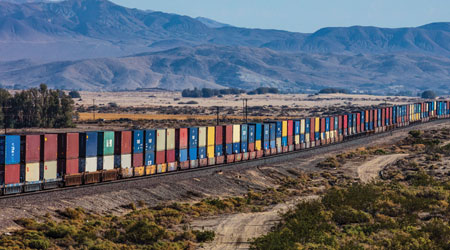
Since the International Longshore and Warehouse Union and Pacific Maritime Association reached tentative contract agreements last month — ending a long labor action — BNSF expects intermodal volumes to increase at West Coast ports in the year’s second half. That bullseye among hoped-for positive developments is one reason more capacity is in the offing.
“We have added a combination of physical capacity and process improvements at our intermodal facilities, and have announced further investments,” said Farmer.
Capacity’s crucial in California
Although there are a number of intermodal capacity-enhancing projects on BNSF’s docket this year, some of the vital ones are located in California, which the railroad considers the linchpin of its network. Those projects include a multiyear expansion of the Stockton terminal; ongoing additions and improvements to the San Bernardino terminal; and the continuing development of a major terminal and yard near Barstow that’s projected to open in four or five years.
In addition, a multiyear expansion/improvement of the Cicero, Illinois, terminal near Chicago ranks high among crucial work.
Combined, the projects will help ensure the Class I is better positioned to meet its growth objectives, says Tom Williams, the group vice president of BNSF’s consumer products business group.
“We are very optimistic about our growth potential, even though we’re not seeing the individual [traffic] numbers we had seen in 2018,” he says. “There is still lots of freight on the highways that could be more reliably and sustainably moved by rail.”
A beefed-up Stockton terminal can help accommodate more truck diversions, BNSF officials believe. Located near Interstate 5, the facility is the primary node for freight moving into and out of California. For example, temperature-controlled traffic moves in high volumes in the state, says Williams.
Work will start this year to add one production track, two incremental support tracks and 950 parking stalls at the northern California facility. By the time the project concludes next year, the Stockton terminal’s production is expected to increase significantly.
Meanwhile, work at the Cicero terminal began last year and will conclude this year. The terminal is unusual, with two hubs on either side of a mainline, says Williams.
In 2022, a bridge was built to connect parking areas and 400 parking spots were added. This year, crews will construct receiving and departure tracks.
Accessible via I-55 and I-290, the Cicero terminal is a key facility for traffic moving to and from the Pacific Northwest, says Williams.
Wider, longer and straighter
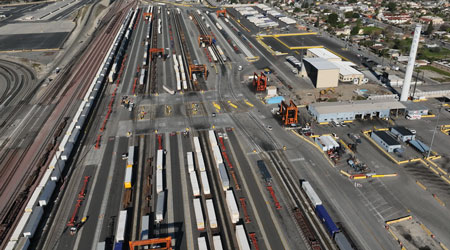
A new bridge also is part of work pegged for the San Bernardino terminal, which is near I-215. BNSF and its predecessors have operated in San Bernardino for more than 135 years.
A bridge built in 1930 was removed last year and the Class I is working with the city to replace it. Construction on the new bridge — which will be twice as wide as the previous structure — will start next year, says Williams.
Other work planned at the terminal includes new receiving and departure tracks, straightening some tracks so they can be used more efficiently and a new Ono Lead, which is considered an essential improvement.
BNSF plans to extend an east lead track 10,000 feet to the existing Ono support tracks to increase the San Bernardino terminal’s switching capacity and improve operational efficiency.
To be completed in 2024, the project involves extending the terminal’s existing A Yard lead track by 3.1 miles so it stretches about 5.6 miles. A fourth lead track would be constructed within/along 4.3 miles of the existing corridor from the A Yard lead track to two existing Ono storage sidings.
The continuous lead track will close an existing gap between the sidings and improve the flow of trains in and out of the A Yard. In addition, traffic congestion will be relieved along the three existing lead tracks that serve BNSF’s east-west corridor.
Overall, the project will enable A Yard crews to better assemble and hold outbound trains, and move rail cars without obstructing mainline trains.
The Ono lead track and San Bernardino terminal are critical fluidity components for intermodal shipments moving along the east-west route to and from the ports in Los Angeles and Long Beach.
BNSF also continues to work on several other infrastructure projects designed to positively impact intermodal traffic. About 45 miles of triple track remain under construction between Barstow and Needles, California, with about 30 miles expected to be completed in 2023. Plus, 50 miles of double track still are being worked on in Kansas to close one of the last major single-track sections remaining on the railroad’s Southern Transcon route between the West Coast and Chicago.
Work also will start this year on a new second main track bridge over the Missouri River in Sibley, Missouri. To be completed in a few years, the bridge will significantly complement double-track work completed west of Kansas City, helping to boost transit times and operational consistency, and improve the railroad’s ability to handle seasonal volume swings across the Southern Transcon.
BIG plans near Barstow
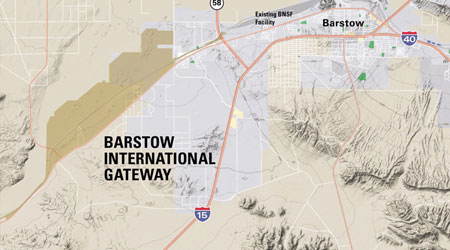
Another major project is pegged for completion in several years — and it’s quite the BIG project. By 2027 or 2028, BNSF expects to open the Barstow International Gateway (BIG) facility near Barstow.
To be built in the high desert region in San Bernardino County about 130 miles from the L.A. and Long Beach ports, the $1.5 billion BIG will feature a rail yard, intermodal facility and warehouses for transloading freight from international containers to domestic containers. The facility will be located near I-15 and I-40 at the west end of the Southern Transcon, where the railroad splits into lines heading to Northern California and the Southern California basin.
Covering 4,500 acres, it will be the largest facility BNSF has ever developed — both Logistics Park Chicago and the railroad’s Alliance, Texas, terminal could fit side by side in BIG’s footprint, says Williams.
BIG will support the direct transfer of containers from ships at the L.A.-area ports to trains for transport by BNSF trains through the Alameda Corridor to Barstow without generating additional truck trips. Containers then will be processed and staged on trains moving east via BNSF’s network.
Similarly, westbound freight will be processed at the facility to more efficiently deliver trains to the ports and other California terminals. In addition, transload warehouses will expedite goods repackaging and processing into domestic containers for further transport via rail across the country.
Currently, most international cargo at the L.A.-area ports arrives in 40-foot containers that are trucked to warehouses in Los Angeles or the region’s Inland Empire. They are then unloaded, sorted and reloaded onto 53-foot domestic containers and trucked to a rail yard in Los Angeles, where they are transferred onto trains or other trucks.
The process creates inefficiencies and unnecessary truck trips within the L.A. region that can impact supply-chain distribution, the environment and surrounding communities, BNSF officials say.
“BIG will be beneficial to all users and supply chains of our network. It creates a far better mousetrap,” says Williams.
A model facility
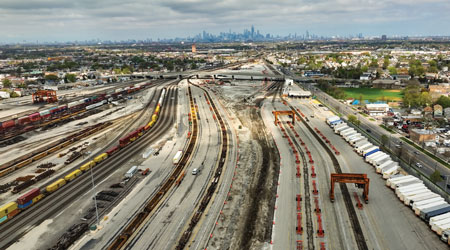
An evolution of a traditional intermodal facility model, BIG is the result of the railroad’s efforts to improve the intermodal supply chain, BNSF officials say. It offers multiple customer benefits, such as lowering supply-chain costs and reducing carbon emissions.
The facility also will benefit the railroad’s intermodal partners by reducing dwell at the ports and providing a lower-cost rail move to an inland transloading facility versus a truck move to existing facilities, said Farmer.
“The onsite integrated warehousing capabilities that facilitate the conversion of international containers to domestic loads will be a big advantage for our customers,” she said.
Ultimately, BNSF officials believe BIG will help provide access to global supply chains via the fastest intermodal route on the Southern Transcon and improve global supply-chain fluidity by hastening the movement of containers off ports.
There are potential local benefits, too. BIG is projected to generate 20,000 direct and indirect jobs in the region, including Barstow and several other high desert communities.
“It will boost the local economy, providing job opportunities for the community and enabling our residents to work closer to home, spend less time on the road and enjoy more time with their families,” said Dawn Rowe, the Third District supervisor for San Bernardino County, in an email.
For now, BNSF is working on traffic and habitat analyses and crafting a draft environmental impact report for the facility. Expected to be completed in 2025, the report will require a city vote. Construction on BIG might start in 2026.
Although BIG is designed as an alternate solution for containerized import traffic, BNSF also is trying to expand its domestic inland intermodal capacity where populations and goods consumption continue to grow the fastest. That includes markets such as Denver, North Texas and Phoenix.
For example, BNSF has developed long range plans to construct an intermodal facility and logistics park near the towns of Hudson and Lochbuie on the east side of I-76 in Weld County, Colorado. That’s part of a broader plan to acquire land to continue making significant investments in the intermodal network.
Tech is vital, too
Another broad plan? Employing more technology to boost intermodal network fluidity and efficiency. Technologies can optimize both unit loading and de-ramping, support inventory accuracy, improve transit consistency and provide critical information in real time, BNSF officials say.
The Class I recently enhanced its RailPASS truck driver interface application and implemented a new pickup appointment system for stacked units at Logistics Park Chicago to reduce dray drivers’ time spent in the facility and boost efficiency. More than 80,000 drivers use RailPASS to expedite gate transactions, locate specific units and perform other essential in-yard tasks at BNSF’s Intermodal hubs. They can use a smartphone or tablet to download the app from the Google Play Store or Apple Store.
In addition, BNSF is testing an artificial intelligence (AI)-based algorithm at its Alliance terminal to help with train loading decisions. Typically, a manual planning process is used to determine how an outbound train should be loaded while load-planning rules address a container’s weight, length, contents and stacking. Any unit that’s improperly assigned or handled can cause lost time to correct.
The algorithm is designed to create a load plan for an outbound train in seconds. It can help ensure the right containers and trailers are located where required on production tracks and that all available space on an outbound train is utilized.
The tests have improved average train-loading time by more than 30 minutes, says Williams. With about 10 outbound trains a day, the terminal has gained annual capacity of about 30,000 additional lifts.
“We have found that hostlers can save an average of 20 miles driven per loaded train since they are closer to parking spots,” says Williams, adding that the algorithm also helps improve fuel consumption, enhance sustainability and drive optimization.
BNSF plans to roll out the algorithm to all intermodal facilities over the next several years. At that time, the Class I anticipates increasing total annual capacity to 500,000 lifts just from that one technological improvement, says Williams.
Driver assistance
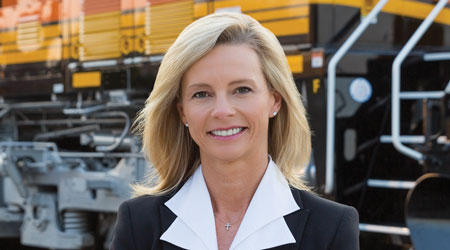
Also at Alliance, BNSF is testing an AI platform developed to help hostler drivers move containers more efficiently from parking lots to tracks or from tracks to parking lots. Currently at intermodal facilities, the drivers rely on manual radio instructions from ramp supervisors and sometimes are provided random routes.
Using cloud computing and asset digitalization that factors in tracks, rail cars, containers, hostlers and cranes, an AI-based algorithm produces an assignment plan. Then in real time, drivers receive instructions where the nearest containers are and the optimized distance/time it will take to load a rail car.
The technology can help trim hostlers’ driving distances, lower carbon emissions and reduce train loading/unloading time.
Moreover, AI-based algorithms are undergoing tests to predict the dwell time of an intermodal train at terminals. A train heading from Chicago to Southern California can pass through nine terminals before reaching its destination.
Dwell time might be increased by the number of trains currently in a terminal and the amount of work associated with each train. The algorithms analyze the recent history of similar trains as they pass through each terminal over the course of their route to better predict dwell time.
Early testing has found an intermodal train’s estimated time of arrival can be shortened by as much as 20%.
Although there are a number of lingering questions regarding the health of the intermodal market — such as how consumer spending might fare for the remainder of 2023 — BNSF leaders believe they have the answers to seize more opportunities when they arise. It’s all about being better positioned, better armed and better intertwined to suit changing demands.
“We’re creating an integrated intermodal network, both physically and digitally, to ensure we are a supply-chain partner of choice into the future,” says Williams.
Email questions or comments to jeff.stagl@tradepress.com.


 LRW Honors Amtrak’s Acheson As Railway Woman Of The Year
LRW Honors Amtrak’s Acheson As Railway Woman Of The Year
 From Editor-In-Chief Foran: Of Gender Equity And Inclusion
From Editor-In-Chief Foran: Of Gender Equity And Inclusion
 Spotlight On Some Of Today’s Rail Safety Products
Spotlight On Some Of Today’s Rail Safety Products
 Women of Influence in Rail eBook
Women of Influence in Rail eBook
 railPrime
railPrime